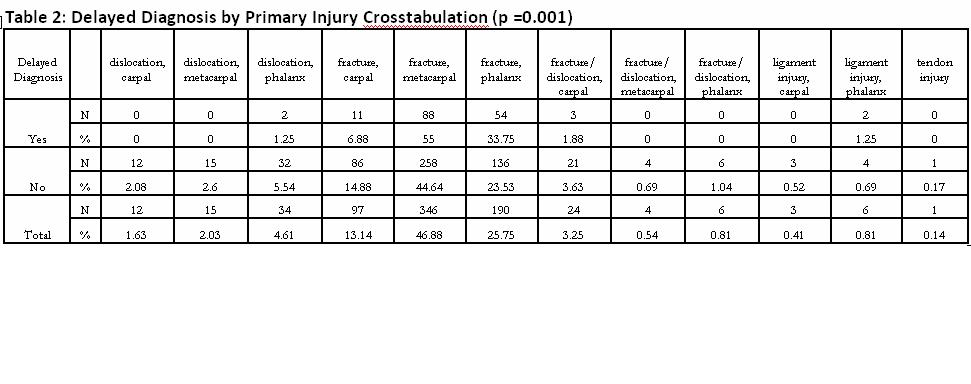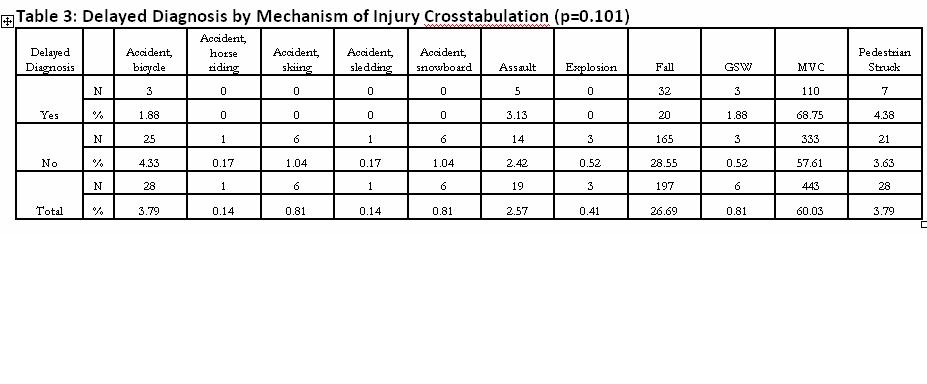|
|
 |
Back to 2011 Program
Delayed Diagnosis of Hand Injuries in Poly-Trauma Patients
Joshua M. Adkinson, M.D.1, M. Shuja Shafqat, M.D.2, Sherrine M. Eid, M.P.H.1, Marshall G. Miles, D.O.1.
1Lehigh Valley Health Network, Allentown, PA, USA, 2Drexel University College of Medicine, Philadelphia, PA, USA.
BACKGROUND:
Hand injuries represent 5-10% of emergency room visits in the U.S. with significant economic effects. Trauma patients are at a particularly high risk for delayed diagnosis of concomitant injuries, including hand injuries, with reports in the literature as high as 50%. As a result, patients may have prolonged disability and longer hospital stays with associated increased costs. The objective of this study is to elucidate risk factors for delayed diagnosis of hand injuries.
METHODS:
A retrospective review was performed on all admitted trauma patients from 2000 through 2009. Patients were assessed for age, gender, blood alcohol level, Glasgow Coma Score (GCS), Injury Severity Score (ISS), mechanism, injury type, and length of stay (LOS). Timing of hand injury diagnosis (time of consultation, positive imaging studies, or chart documentation) related to admission date was noted. A multiple linear regression model was used to determine risk factors for delaying the diagnosis of hand injuries. All analyses were performed using SPSS 15.0 (SPSS Inc, Chicago, IL).
RESULTS:
The database consisted of 36,568 patients; 2736 with hand injuries. After excluding patients with an obvious diagnosis of or mechanism for hand injury, 738 patients were identified. 21.7% of patients had a delayed diagnosis with 91.3% of patients diagnosed by the second hospital day (Table 1).

Age-adjusted odds ratio for likelihood of a delayed hand injury diagnosis was >2 times higher for severely injured patients (OR =2.014 95%CI [1.144, 3.549]) with 30.4% of patients with severe injuries having a delayed diagnosis. Average GCS for patients with delayed diagnosis was 12.95, while patients with diagnosis at time of admission had GCS of 14.16. Patients with delayed diagnosis had an average LOS of 10.41 days vs. 5.99 days for those diagnosed at time of admission. Metacarpal fractures were the most common injuries overall (46.88%), and the most common injury for which the diagnosis was delayed (Table 2).

Motor vehicle collisions were the most common mechanism overall (60.03%), and the most common mechanism for which the diagnosis was delayed (Table 3).

CONCLUSIONS:
With an increase in injury severity score, trauma patients are increasingly at risk for delayed diagnosis of hand injuries with a concomitantly increased length of stay. As a delayed diagnosis of hand injuries has both significant physical and economic implications for patients, every effort should be made to expedite diagnosis in the poly-trauma patient. A standardized evaluation of the trauma patient with a focused tertiary survey is mandatory, particularly in patients with an altered mental status or with multiple injuries.
Back to 2011 Program
|







